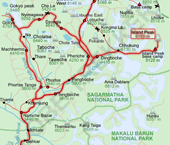
» Ville fjell og vennlige mennesker
» Nepalsk ornitolog kikket pa Lista
» Namaste Nepal passer for reiseskildringer














&
Temparature
Island Peak Climbing:
 Our Island Peak trip is a special trek, which combines an ascent of Island Peak with a visit to the famous lakes of the Gokyo area. We start from Lukla and trek slowly up the Dudh Koshi valley. After a few days we branch off to Gokyo, and after climbing Gokyo Ri for fantastic views of Cho Oyu and Everest we cross the Cho La and descend to Dingboche to prepare for the ascent of Island Peak. Island Peak was the name given to the mountain in 1952 by Eric Shipton's party who thought it to be reminiscent of an island in a sea of ice. It is also known by it's Nepali name of Imja Tse. Island Peak is an extension of Lhotse Shar, and is located between the Lhotse and Imja glaciers, standing at 6,189m/20,305ft.We ascend by the standard route and although the summit can be reached in one day from base camp, we make use of a high camp. The final ridge is a classic of it's kind and from the summit fabulous views can be enjoyed of many Himalayan giants including the immense south face of Lhotse and the huge peak of Ama Dablam.
Our Island Peak trip is a special trek, which combines an ascent of Island Peak with a visit to the famous lakes of the Gokyo area. We start from Lukla and trek slowly up the Dudh Koshi valley. After a few days we branch off to Gokyo, and after climbing Gokyo Ri for fantastic views of Cho Oyu and Everest we cross the Cho La and descend to Dingboche to prepare for the ascent of Island Peak. Island Peak was the name given to the mountain in 1952 by Eric Shipton's party who thought it to be reminiscent of an island in a sea of ice. It is also known by it's Nepali name of Imja Tse. Island Peak is an extension of Lhotse Shar, and is located between the Lhotse and Imja glaciers, standing at 6,189m/20,305ft.We ascend by the standard route and although the summit can be reached in one day from base camp, we make use of a high camp. The final ridge is a classic of it's kind and from the summit fabulous views can be enjoyed of many Himalayan giants including the immense south face of Lhotse and the huge peak of Ama Dablam.
itinerary
Day 4 Fly to Lukla, trek to PhakdingAfter a very early start, and an early take off from Kathmandu Domestic Airport, a 45
minute flight is all it takes to propel us into the Everest region of Nepal. The landing at
Lukla (2800m) is spectacular and on arrival we are greeted by our sirdar and trekking
Crew who organise the luggage and hustle us off for tea. After a leisurely lunch we start
the trek in earnest, setting off for a gentle walk to Phakding (2800m), a further 3 hours to
the north. The trail leads through Lukla, past hotels, shops and airline offices to the edge
of the Lukla plateau where the trail drops to meet the intersection of the Jiri trail at
Chablung. From here the trail follows the Dudh Koshi north through the village of Ghat
and then finally to Phakding where we spend the night.
Day 5 Phakding to Namche Bazaar
From Phakding the trail continues north up the Dudh Koshi Valley, staying 100m above the river on it's west bank. The trail leads us to Jorsale (2810m) where we enter the
Sagarmatha National Park, and submit our trekking permits for checking. From here we
continue on an ever-steepening trail to Namche Bazaar (3440m), known simply as Namche. En route we cross the spectacular suspension bridge high above the confluence of the Bhote Koshi and the Dudh Koshi, and shortly after glimpse our first view of Everest,
way off to the north-east. The trail to Namche is steep and long, but eventually we reach
the remarkable Sherpa capital perched high on the hillside and dominated to the east by the immense bulk of Kwangde (6187m).
Day 6 Acclimatization day in Namche Bazaar
Acclimatization is important before trekking higher, and this is a scheduled stop which will allow us to gradually become used to the effects of altitude - the lower pressure and
the thinner air. We can spend the day by taking a side trip to Thami or Khumjung, by
visiting the National Park Visitor Centre on the hill above Namche or by simply resting and browsing in the shops in the town. Namche is a fascinating place simply to 'hang out' and take in the culture of the mountains, from the trading of visiting Tibetans to the stories of departing mountaineers.
Day 7 Namche Bazaar to Phortse Thanga
From Namche we trek north-east on a direct line to Everest, starting up the hill to the Visitor Centre and continuing on a reasonably flat easy trail high above the Dudh Koshi.
Ahead of us we can see one of the most beautiful mountains in the Khumbu - Ama
Dablam (6856m), as well as Everest still far off in the distance. At Sanasa we branch off the Everest trail and head up the hill to the small settlement of Mong where we stop for
lunch. From here it is a steady descent to the Dudh Koshi at Phortse Thanga (3500m). This is a beautiful riverside settlement and is our camping spot for the night.
Day 8 Phortse Thanga to Dole
From the river the trail initially climbs steeply out of the valley through rhododendron forest and then continues high above the Dudh Koshi, steadily gaining height. We pass
through the settlements of Tongba (3950m) and Gyele (3960m) and eventually reach our
camp site for the evening at Dole (4200m). All through the day we have fantastic views of the surrounding mountains.
Day 9 Dole to Machhermo
From Dole the gain in altitude to our next evening's camp site is small, only 190m. The
trail continues high above the west bank of the Dudh Koshi and we obtain tremendous
views of the mountains at the northern end of the valley, including Cho Oyu, as well as
back down the valley to Ama Dablam, and across the valley to Tawachee and Cholatse.
Machhermo at 4410m is a pleasant camp site with several tea-houses.
Day 10 Machhermo to Gokyo
Beyond Machhermo the valley widens and the trail passes through the settlement of Pangka before descending to the river. From here it is a steep ascent up the terminal
moraine of the Ngozumpa glacier to the first of the Gokyo lakes at 4650m. The trail
then sevels off and passes the second lake at 4690m, eventually making it's way to Gokyo
at 4750m.Gokyo is a sizeable settlement with many tea-houses, located in a delightful location on the edge of the lake, and is the main objective for many of the trekking groups that we will encounter. The views from Gokyo are magnificent and tomorrow we will climb the small hill above Gokyo village, known as Gokyo Ri, to obtain fantastic views of Everest and Cho Oyu.
Day 11 Climb Gokyo Ri, trek to Chhugyuma
We start the day by slowly ascending to the top of Gokyo Ri at 5350m, and are rewarded
by magnificent views of Everest to the east and Cho Oyu to the north. After descending
to Gokyo and resting we retrace our steps to the area between the first and second lakes
and take a trail eastwards across the Ngozumpa glacier. This takes us to the small
settlement of Dragnag where there is a tea-house. From here we will continue upwards and camp at Chhugyuma at approx. 5000m.
Day 12 Cross Cho La to Dzongla
We make an early start, and continue upwards towards the pass that links the Gokyo and
Everest valleys - the Cho La. From our camp site it is about 3-4 hours of slow walking to the pass at 5420m. Whilst this is a hard morning's walk, we are rewarded by fabulous
views on both sides of the pass. From the pass we descend slowly on a rough trail to the small settlement of Dzongla where there are a few tea-houses. We make our camp here,
and have a superb view of the immense peak of Cholatse.
Day 13 Dzongla to Chhukung
From Dzongla we descend steadily to the main Everest trail at Duglha, and from here continue to descend to the ridge above Dingboche where we obtain our first view of Island Peak as it dominates the end of the Imja valley to the east. We take lunch at
Dingboche, the large sprawling Sherpa settlement at 4410m, before continuing up the Imja valley to Chhukung at 4730m. The immense south face of Lhotse towers above the village to the north.
Day 14 Chhukung to Island Peak Base Camp, then on to High Camp
From Chhukung we continue in a general easterly direction to the site of our base camp. The trail follows the moraine of the Lhotse glacier to the snout of the Imja glacier where
it branches to the east and skirts around the base of Island Peak. We make our main camp at a spot known as Pareshaya Gyab at 5087m.After taking lunch and resting we continue up to our high camp, a further hour or so up the mountain. The trail is well defined until we reach the area of our high camp at approx. 5500m.
Day 15 Ascent of Island Peak and return to Base Camp
We set off early for the summit at about 3.00 am, and scramble up in the dark to the snow-covered glacier above. From here we take care as we make our way up the glacier until we reach a broad snow basin which leads up to the final section of the climb. Ahead of us now is the main summit ridge and we climb a steep snow and ice slope, using fixed ropes, for approx. 100m to access the ridge. The ridge is a classic and leads quickly to the east up to the main summit at 6189m. From the summit there are fantastic across to Lhotse to the north, the Amphu Labsta and Mera Peak to the south, and Ama Dablam to the west. After taking in the views we descend by the same route, abseiling from the ridge, and making our way back carefully to Base Camp.
Day 16 Spare Day
We allow a spare 'buffer' day in case of bad weather.
Day 17 Island Peak Base Camp to Dingboche
We retrace our steps back down the Imja valley, firstly to Chhukung where we stop for lunch, and on to Dingboche where we spend the night. This is a chance to celebrate our success with a cool beer, and reflect upon the climb of the previous day.
Day 18 Dingboche to Namche Bazaar
From Dingboche we head down the main Everest trail, passing through the settlement of Pangboche, before reaching the famous Tengpoche monastery where we stop for lunch. We have a chance we visit the monastery before continuing on to Namche Bazaar. From Tengpoche the trail drops steeply to the river at Phunki Thanga, and then rises again to traverse high above the river on a winding trail into Namche Bazaar.
Day 19 Namche Bazaar to Lukla
The final day of our trek, and a sense of relief for some and sadness for others as we retrace our steps of the first few days along the trail above the Dudh Koshi before turning off the main Jiri route and rising up to Lukla. We start by descending steeply out of Namche and shortly before we cross the suspension bridge below Namche we get a last chance to see Everest before it is out of sight until the next time. We lunch at Phakding and arrive in Lukla by mid-afternoon.
- The mix of Touring and/or general Trekking,
- The remoteness of the areas visited,
- The number of guides or porters required,
- The standard of accommodation required (if there is a choice),
- The type of ground transport used,
- The length of your visit, and
- The size of your group.
Depending on group size the costs of treks and tours range from:
1 to 3 pax US$ 88 to 163 P/p per night.
4 to 8 pax US$ 78 to 148 P/p per night
9 to 14 pax. US$ 75 to 135 P/p per night.
15 to 20 and above US$ 60 to 110 P/p per night
Single supplement US$ 40 to 70 per night.
Note: The itinerary and cost for Peak climbing, Mountaineering, Tibet, Bhutan and India tours and trek are conditional apply.
Notwithstanding the costs shown above, we can tailor tours to suit almost any budget. Feel free to email us for more information.
Note: One tour leader will be free of cost for tours with 15 or more paying guests only.
Children's bellow three years is free if sharing with their parents. And need to pay if they are participating on the trekking, and above three to nine year children half of the price.
Cost Includes: Accommodation in 3 to 4 star hotels in the cites as your choice, basic accommodation in a lodge or tea house or camping (depending on your itinerary and choice) during treks, guides and porters on treks, all land transfers by private vehicle, 3 meals a day on treks, all jungle safaris, all sightseeing tours as per itinerary and all necessary entry fees, permits and airport transfers.
Cost Excludes: Personal expenses, domestic air tickets, airport tax, drinks (soft drink, mineral water and alcoholic beverages and hot-shower on the trek), personal insurance, and extra cost due to natural calamities or accidents outside of our control.
Please note that our guides speak the following English languages and if required we will provide your language spiking guide on extra cost.
Note: Please contact exploretrek@wlink.com.np for more information and prices
Translate
Contact Information:
Alpine Explore NepalP.O. Box: 4546, Kathmandu, Nepal
+977 1 4700714 / 4700175 / 4701974
Fax: +977 -1 - 4700970
Email: info@traveltrek.asia
sales@traveltrek.asia
Skype Address: explore.alpine
MSN Messanger: explorealpine
Yahoo Messanger:explorealpine

Unlimited Everest Rolwaling Trek with Panorama Views Amazing Annapurna Manang, Tilicho Lake and Thorangla-Pass Jomsom Manaslu and Annapurna Hidden Valley Trek, Manang Everest with High Pass Trekking Upper Mustang TrekWestern Nepal Dolpo Rara Lake Trek


Our Guest Says
SteveAnyon-Smith18 April 2000
This was my third trek in Nepal, having visited the Annapurna Region in 1995 and with Bharat and Dave in the beautiful and wildlife-filled Langstang Valley in1998. Bharat's company "Explore Alpine Adventure"....












